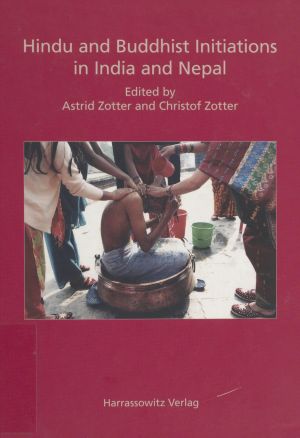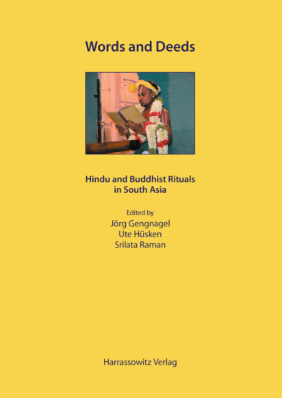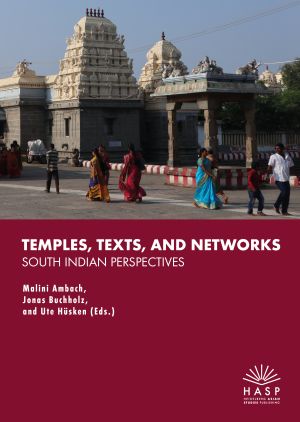Hüsken, Ute
Hindu and Buddhist Initiations in India and Nepal
Für die wissenschaftliche Betrachtung von Initiationen in hinduistischen und buddhistischen Traditionen sind vor allem zwei Arten von Ritualen relevant: lebenszyklische Initiationen, die in vielen Gemeinschaften begangen werden und die abhängig von Alter und Geschlecht obligatorisch sind, sowie solche, die eher optional sind und den Zugang zu einer bestimmten religiösen Gruppe oder Praxis ermöglichen. In diesem Band behandeln Vertreter verschiedener Disziplinen Beispiele für beide Arten von Ritualen in unterschiedlichen religiösen Kontexten. Von besonderem Interesse sind dabei Verflechtungen zwischen verschiedenen Initiationen und ihre Beziehungen zu anderen Ritualarten. Die Beiträge untersuchen spezifische Aspekte von Initiationen und zeigen dabei ihre Dynamiken auf. Eines der wiederkehrenden Themen ist der von Anpassungen an neue Kontexte begleitete Transfer von Ritualelementen, der mit Modifikationen von Abläufen oder Neuzuweisungen von Bedeutungen einhergeht. Darüber hinaus diskutieren die Autoren Beziehungen zwischen Vorschrift (Ritualhandbücher) und Performanz oder Kräfte des Wandels (z.B. Ritualökonomie, geschlechterspezifische Variationen, Modernisierung und Demokratisierung).
Die Vorschriften für die buddhistische Nonnengemeinde im Vinaya-Piṭaka der Theravādin
Wohl gegen Ende des ersten nachchristlichen Jahrtausends endete die Ordinationstradition der Nonnen der buddhistischen Theravāda-Schule. Dennoch werden auch die Verhaltensvorschriften der Nonnen, die ebenso wie die der Mönche als Buddhawort gelten, in der Sammlung der kanonischen Texte weiterhin überliefert. In der vorliegenden Untersuchung wird das Regelkonvolut für Nonnen der Theravāda-Tradition ausgehend von den besonderen Nonnenregeln im Buch der Ordensdisziplin (Vinaya-Piṭaka) und den relevanten Kommentarstellen in der Samantapāsādikā dargestellt und mit den Verhaltensvorschriften für die Mönche derselben Überlieferung verglichen. Die Arbeit ist eine überarbeitete Fassung der 1995 vom Fachbereich Historisch-Philologische Wissenschaften der Georg-August-Universität in Göttingen angenommenen Dissertation.
Viṣṇu's Children: Prenatal life-cycle rituals in South India
Die Vaikhānasas, eine Gruppe brahmanischer Priester in den südindischen Viṣṇu-Tempeln, können auf eine lange und bewegte Geschichte zurückblicken, die von dem Bemühen geprägt ist, ihren Status gegenüber rivalisierenden Priestern zu behaupten. Im Mittelpunkt der Monographie steht eine seit Jahrhunderten andauernde Kontroverse darüber, was eine Person dazu berechtigt, die Rituale in Viṣṇu-Tempeln durchzuführen: Erschafft die Geburt oder eine Initiation den idealen Vermittler zwischen Gott und Menschen? Seit dem 14. Jahrhundert n. Chr. drehen sich die Diskussionen in den einschlägigen Sanskrit-Texten um die Frage, ob die Vaikhānasa-Priester sich einer Initiation mit Brandmarkung auf den Oberarmen unterziehen müssen oder ob ihr besonderes vorgeburtliches Lebenszyklusritual Viṣṇubali sie berechtigt, Tempelrituale durchzuführen. Als erbliche Tempelpriester ist die Haltung der Vaikhānasas eindeutig: Sie verstehen sich als Viṣṇus Kinder, die bereits vor der Geburt für den Tempeldienst bestimmt sind. Neben den textlichen Perspektiven werden drei lokale Konflikte aus dem 19./20. Jahrhundert um die Frage analysiert, ob die Vaikhānasas sich einer Initiation unterziehen müssen. Darüber hinaus werden drei Beispiele aktueller Ausführungen des Viṣṇubali-Rituals vorgestellt und im Lichte der Beziehung zwischen Text und Aufführung interpretiert.
Die ursprünglich auf einer dem Buch beigefügten DVD veröffentlichten Filme sind auf der Multimedia-Datenbank heidICON archiviert und können über die nachfolgenden Links abgespielt werden:
- Introduction (length 08:10 min)
- Full ritual (length 28:28 min)
- Prepatory rites - Formal declaration (03:51 min)
- Prepatory rites - Vitalisation of the sacrificial fire (06:45)
- Main offerings - Pūjā for Viṣṇu's twelve forms (11:09 min)
- Main offerings - Offering into the fire (09:01 min)
- Main offerings - Viṣṇu marks the unborn child (09:53 min)
- Atonement for ritual flaws (03:46 min)
- Concluding rites (04:43)
- Credits
Words and Deeds: Hindu and Buddhist Rituals in South Asia
Words and Deeds ist eine Sammlung von Artikeln über Rituale in Südasien mit besonderem Augenmerk auf deren Texte und Kontext. Der Band geht davon aus, dass eine umfassende Definition von "Ritual" nicht existiert. Stattdessen vermeiden die Beiträge essenzialistische Definitionen, so dass sich eine polythetische Definition des Begriffs herausbilden kann. Der Band enthält Beiträge zu Initiation, vorgeburtlichen Riten, religiösen Prozessionen, königlichen Weihen, Ritualen, die den Beginn eines Rituals markieren, Ritualen der Hingabe und vedischen Opfern sowie Beiträge, die sich mit allgemeineren theoretischen Fragen des Studiums von Ritualtexten und ritueller Praxis befassen, und zwar sowohl aus der ätischen als auch aus der emischen Perspektive. Diese Studien zeigen, dass jede Untersuchung der Beziehung zwischen dem Text und dem Kontext von Ritualen auch die Möglichkeit in Betracht ziehen muss, dass verschiedene Kategorien von Ausführenden die Beziehung zwischen ihrem rituellen Wissen und ihrer rituellen Praxis, zwischen Text und Kontext auf unterschiedliche und nuancierte Weise subjektiv konstituieren können und dies auch tun.
Temples, Texts, and Networks: South Indian Perspectives
Seit vielen Jahrhunderten sind hinduistische Tempel und Schreine für das religiöse, soziale und politische Leben Südindiens von großer Bedeutung. Sie sind nicht nur Andachtsstätten, sondern auch Pilgerziele, Orte der Gelehrsamkeit, politische Brennpunkte und Wirtschaftszentren. In diesen Tempeln interagieren nicht nur Menschen und Götter, vielmehr sie sind auch Treffpunkte für Angehörige verschiedener Gruppierungen von nah und fern. Hindu-Tempel existieren nicht isoliert, sondern stehen auf vielfältige Art in Beziehung zu anderen Tempeln und heiligen Stätten. Sie nehmen durch Architektur, Ritual oder Mythologie Bezug aufeinander oder sind konzeptionell verbunden, wenn bestimmte Stätten zu einer Gruppe zusammengefasst werden. Vor allem in städtischen Zentren können mehrere Tempel, die verschiedene religiöse Traditionen repräsentieren, in einem gemeinsamen sakralen Raum koexistieren. Der vorliegende Band widmet sich den Verbindungen zwischen einzelnen Hindu-Tempeln und den mit ihnen verbundenen Gruppierungen, sei es innerhalb eines bestimmten Ortes oder auf überörtlicher Ebene. Diese Verbindungen werden als "Tempelnetzwerke" beschrieben, ein Konzept, das anstelle von stabilen Hierarchien und Strukturen nodale, multizentrische und fluide Systeme betrachtet, in denen Verbindungen in verschiedenen Bereichen der Interaktion als dynamische Prozesse verstanden werden.
Rezensionen
Amol Saghar in IIAS Reviews (2023)
Malini Ambach, Jonas Buchholz und Ute Hüsken im Gespräch im Raj Balkaran bei New Books Network (2022)












